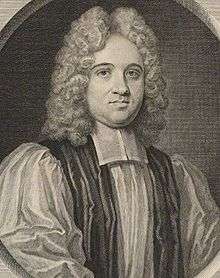Sir William Dawes, 3rd Baronet
Sir William Dawes, 3rd Baronet (12 September 1671 – 30 April 1724), was an Anglican prelate. He served as Bishop of Chester from 1708 to 1714 and then as Archbishop of York from 1714 to 1724. Politically he was a Hanoverian Tory, who favoured the Hanoverian Succession.
Sir William Dawes | |
|---|---|
| Archbishop of York | |
 | |
| Province | York |
| Diocese | York |
| In office | 1714–1724 |
| Predecessor | John Sharp |
| Successor | Lancelot Blackburne |
| Other posts | Dean of Bocking (1698–1708) Bishop of Chester (1708–1714) |
| Orders | |
| Consecration | 1708 |
| Personal details | |
| Born | 12 September 1671 Lyons, Essex, England |
| Died | 30 April 1724 (aged 52) Westminster, Middlesex, Great Britain |
| Buried | Chapel, St Catharine's Hall, Cambridge |
| Nationality | English (later British) |
| Denomination | Anglican |
| Parents | Sir John Dawes Christian née Lyons |
| Spouse | Frances D'Arcy
( m. 1692; died 1705) |
| Children | 5 sons & 2 daughters[1] |
| Alma mater | St John's College, Oxford St Catharine's Hall, Cambridge |
Education
Dawes was born at Lyons, near Braintree in Essex and from the age of nine attended Merchant Taylors' School in London. Already excelling in Hebrew by the age of 15, he was barely 18 when he wrote his work in verse: The Anatomy of Atheisme, and his eminent The Duties of the Closet in prose.
In 1687, William matriculated at St John's College, Oxford,[2] of which college he also became a fellow, then migrated to St Catharine's Hall, Cambridge in 1689. He graduated Master of Arts (MA Cantab) from St Catharine's in 1695, on royal decree (per lit. reg.) due to his young age; in 1696 he graduated in theology of Doctor of Divinity (DD).[3]
Anglican priest
William Dawes became the permanent pastor of William III (1688–1702) and was later court pastor of Queen Anne (1702–14). From 1698, at a young age, he was Canon of Worcester Cathedral.
He was Master of St Catharine's Hall, Cambridge between 1697 and 1714[4] and Vice-Chancellor of Cambridge, 1698–9.
In 1698 he was appointed rector in the village of Bocking (where the rector is called Dean of Bocking) near to his estates in Essex. Here he introduced the innovative custom of taking Holy Communion not only on the three great feasts, but once every month.
On 8 February 1708[1] he was consecrated Bishop of Chester: this was at the personal wish of Queen Anne, who overruled the advice of her ministers in appointing him. He was Archbishop of York from 1714 until his death in 1724[5] and a Privy Counsellor.[6] He owed his advancement to the good will of the Queen and of his predecessor, John Sharp, who had a great regard for him, and had great influence with the Queen: it was Sharp's dying request that Dawes succeed him at York, which the Queen happily granted. He restored the Archbishop's palace in York, the Bishopthorpe.
He died on 30 April 1724 from inflammation of the bowels. He was buried in the chapel of St Catharine's together with his wife. He was the most outstanding preacher of his period, a representative of the ideal of aristocratic prelate, of a high and authoritative personality.[7]
Family
William Dawes was the son of John Dawes, 1st Baronet of Putney and Christian Hawkins of Bocking. According to Samuel Pepys, his parents' marriage gave rise to a good deal of gossip. His orphaned mother was an heiress, aged only sixteen, and it was claimed that her husband married her without her guardian's consent.[8] After his father's death his mother remarried the noted shipbuilder Sir Anthony Deane, by whom she had eight more children.
William married Frances Cole d'Arcy (1673–1705; daughter of Thomas d'Arcy {1632–1693} and Jane Cole {1640–?}) on 1 December 1692, at St Edmund King and Martyr, Lombard St, City of London.
Their daughter Elizabeth married William Milner (?−1745), 1st Baronet of Nun Appleton Hall, MP for York in the early 18th century.
Styles and titles
- 1690–1695: Sir William Dawes Bt
- 1695–1696: The Reverend Sir William Dawes Bt
- 1696–1698: The Reverend Doctor Sir William Dawes Bt
- 1698: The Reverend Canon Doctor Sir William Dawes Bt
- 1698–1708: The Very Reverend Doctor Sir William Dawes Bt
- 1708–1714: The Right Reverend Doctor Sir William Dawes Bt
- 1714–1724: The Most Reverend and Right Honourable Doctor Sir William Dawes Bt
References
- "Dawes, Sir William". Oxford Dictionary of National Biography (online ed.). Oxford University Press. doi:10.1093/ref:odnb/7336. (Subscription or UK public library membership required.)
- "Dawes, William (DWS695W)". A Cambridge Alumni Database. University of Cambridge.
- "St Catharine's College". Cambridge Online. Retrieved 20 February 2017.
- "No. 5264". The London Gazette. 28 September 1714. p. 1.
- "Pápai Páriz Ferenc, Album amicorum p. 468". ppf.mtak.hu. Retrieved 20 February 2017.
- A genealogical and heraldic history of the extinct and dormant baronetcies ... by John Burke
- Stuart Handley, Dawes, Sir William, third baronet (1671–1724), Oxford Dictionary of National Biography, Oxford University Press, 2004
- Leigh Rayment's list of baronets
- The whole works of ... Sir William Dawes, in 3 volumes, with a preface, giving some account of the life ... of the author. London, 1732, 1733.
Attribution
![]()
| Church of England titles | ||
|---|---|---|
| Preceded by Nicholas Stratford |
Bishop of Chester 1708–1714 |
Succeeded by Francis Gastrell |
| Preceded by John Sharp |
Archbishop of York 1714–1724 |
Succeeded by Lancelot Blackburne |
| Academic offices | ||
| Preceded by John Eachard |
Master of St Catharine's College, Cambridge 1697–1714 |
Succeeded by Thomas Sherlock |
| Baronetage of England | ||
| Preceded by Robert Dawes |
Baronet (of Putney) 1690–1724 |
Succeeded by Darcy Dawes |
